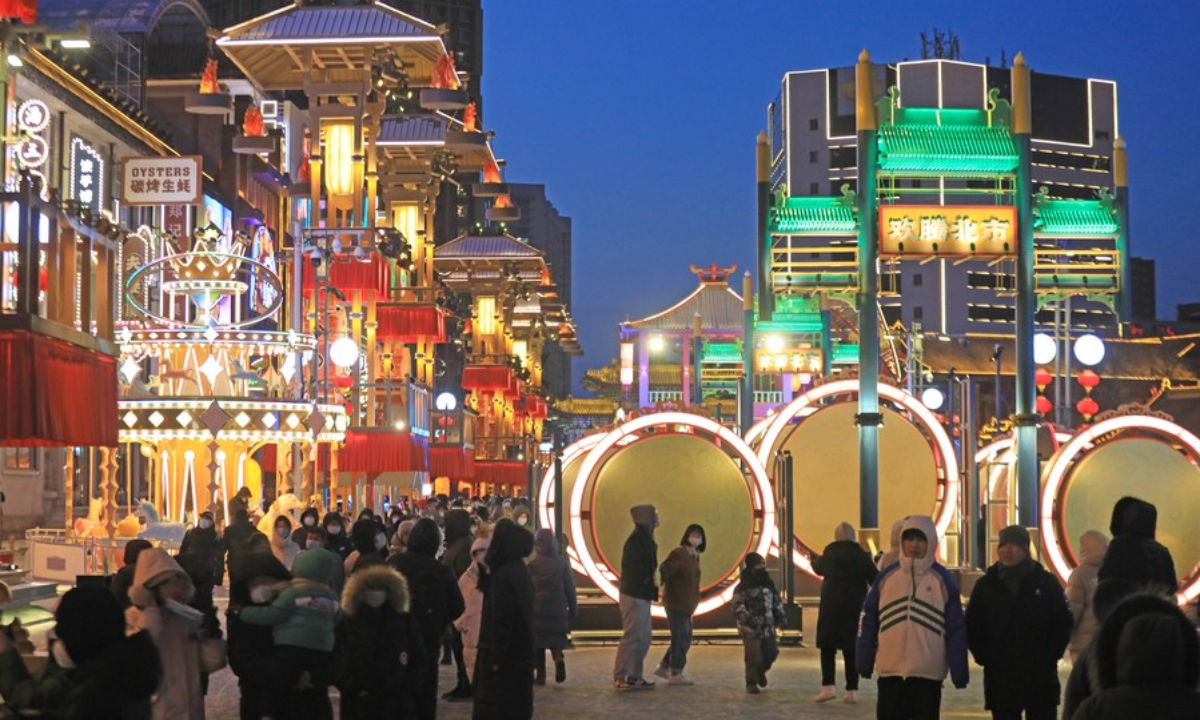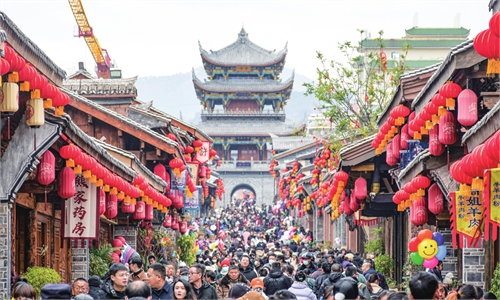A good start from China's Spring Festival brings world warmth: Global Times editorial

People visit Huangsi Temple Fair during the Spring Festival holiday in Shenyang, capital of Northeast China's Liaoning Province, Jan. 23, 2023. Various activities were held here at the 6-day fair, starting from Jan. 22, to celebrate the Spring Festival. (Xinhua/Yang Qing)
During the Spring Festival holidays that just passed, although the temperature in many places plummeted due to the cold wave, the national consumer market has been rising all the way, showing a super hot scene. Popular scenic spots were overwhelmed by crowds, hotels were fully booked, one has to wait more than 1,000 tables in a popular restaurant, and movie theaters were full. The Chinese Lunar Year of the Rabbit ushered in a "good start" with a blowout consumption expansion. The powerful pulse of China's economy is being transmitted to various fields through countless "capillaries," showing the resilience and endogenous power that have impressed the world.Overall, there are two outstanding features of this year's Spring Festival holidays. One is "exceeding expectations" - the return to normal life came sooner than expected. The new round of epidemic outbreaks and lower consumption willingness that people were worried about before the Spring Festival did not appear. Many people dispelled their previous concerns, and the national consumer market recovered at an astonishing speed, which further increased people's confidence and expectations. The second is "the peak in three years." According to the calculations of the Ministry of Culture and Tourism, some 308 million domestic trips were made during the Spring Festival holidays, the highest since the epidemic. Data from multiple travel platforms also show that domestic and outbound travel orders during the holidays hit a three-year high, and many of them even surpassed the numbers in 2019. At the same time, the total box office during the period is booming. As of 9 pm of Friday, it has exceeded 6.724 billion yuan ($991 million), making it the second largest box office of the Spring Festival holidays in Chinese film history.
People's optimism is fully released during this Spring Festival holidays, showing the Chinese people's love for life and enthusiasm for moving forward. This sentiment has continued since the end of last year and the beginning of this year when all places made great efforts to promote development. Since the optimization and adjustment of epidemic prevention and control measures, various places have accelerated the pace of overall economic recovery. The majority of market entities are busy resuming work and production. Batch after batch of local investment groups go abroad to "grab" orders, and some factories and mines even worked overtime to ensure supply during the Spring Festival. These are the driving forces behind the "good start" of the economic sprint in the Year of the Rabbit, and they are also the solid support for society's optimistic expectations for this year.
The "good start" of the Spring Festival holidays shows that the confidence of the Chinese society is rising, and this is just the beginning. Many domestic and overseas institutions have predicted that with the further release of market demand, the tourism market in the second quarter of this year is expected to usher in overall prosperity, which will also greatly promote the recovery process of the global tourism industry. More importantly, this confidence comes not only from the recovery of tourism and other markets, but also from the clear signal recently released by the Central Committee of the Communist Party of China and the certainty of the long-term upturn cycle of the Chinese economy. People's optimistic expectations for the future, combined with factors such as China's huge market, comprehensive industrial system, and stable policy environment, will determine the vigorous trend of the consumer market during the Spring Festival holidays is strongly sustainable.
The Spring Festival holidays have always been an important window for the outside world to observe the trend of China's domestic consumer market, and this year is even more special. As the first Spring Festival holidays after China optimized and adjusted its epidemic prevention and control measures, international organizations, observers from all walks of life, and market traders are eager to get a feel of the strength of China's economy from various data. The strong growth during the Spring Festival this year has made many countries feel a strong sense of warmth. Many Southeast Asian countries are regarded as "big winners" of the holiday, and soon, other places like Europe are expected to start welcoming more and more Chinese tourists. This is undoubtedly an exciting signal for the sluggish world economy. It means fresh blood and vitality, and the benefits brought to various sectors in other countries are tangible.
It is particularly worth mentioning that, unlike many developed economies, China's policy space is still relatively ample, and we have no inflation or food and energy crises experienced by many countries, which means that China's economy is strong. That's a rarity in today's world. In fact, there are signs that global funds are pouring into the Chinese market: Encouraged by China's economic growth momentum, Hong Kong's Hang Seng Index has risen for six consecutive weeks, and the 14 percent rise this month marks the best start in at least three decades. Bloomberg reported, "If the upbeat mood continues, the CSI 300 benchmark may enter a bull market when shares resume trading on Monday."
China in the Year of the Rabbit is on a fairly good starting point. Optimism and vitality have become the key words at the beginning of this year. We have reason to believe that this will also be the main thread running through China's economic performance this year. Although there may still be the impact of uncertainties from the outside world in the future, this impact is bound to be secondary. The "good start" of this Spring Festival, to a large extent, indicates that the Chinese economy is running and heating up in a new round, and this will also melt the difficulties and challenges encountered by the world economy, and facilitate development opportunities.



